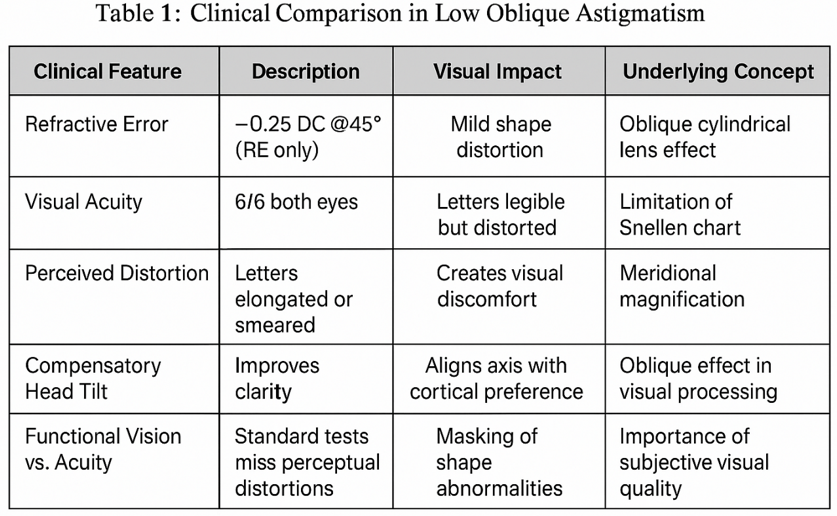Ophthalmology and Vision Care
OPEN ACCESS | Volume 5 - Issue 2 - 2025
ISSN No: 2836-2853 | Journal DOI: 10.61148/2836-2853/OVC
Muhammad Akbar Rashid
Independent Clinical Researcher, Public Health Scholar, Healthcare Manager, Clinical Optometrist.
*Corresponding author: Muhammad Akbar Rashid, Independent Clinical Researcher, Public Health Scholar, Healthcare Manager, Clinical Optometrist.
Received: July 20, 2025 |Accepted: July 30, 2025 |Published: August 08, 2025
Citation: Muhammad Akbar Rashid., (2025). “Visual Distortion in Low Oblique Astigmatism and the Role of Head Tilt in Visual Clarity: A Case Study” Ophthalmology and Vision Care, 5(2); DOI: 10.61148/2836-2853/OVC/063.
Copyright: © 2025 Muhammad Akbar Rashid. This is an open access article distributed under the Creative Commons Attribution License, which permits unrestricted use, distribution, and reproduction in any medium, provided the original work is properly cited.
This case study investigates a patient with low oblique astigmatism who experiences perceptual visual distortion despite achieving 6/6 visual acuity. The distortion manifests as letter elongation or blurring that resolves with a head tilt. Through detailed clinical observation and neuro-visual interpretation, we demonstrate the role of meridional magnification, oblique axis distortion, and cortical orientation processing in the visual disturbances of low cylinder refractive error. The case underscores the importance of functional vision assessment beyond standard acuity metrics
Oblique Astigmatism, Meridional Magnification, Visual Distortion, Head Tilt, Functional Vision, Neurovisual Processing
Astigmatism, a prevalent refractive condition, can result in blurred or distorted vision due to differences in the eye’s refractive power across meridians. While high cylinder values typically warrant correction, even low-power astigmatism especially at oblique axes can yield disproportionately significant perceptual effects due to how the visual cortex processes oblique spatial frequencies (Bradley, Abd El-Motaleb, & Thibos, 2005; Legras, Chateau, & Charman, 2004). This report presents a unique case where a patient with mild oblique astigmatism perceives letter distortion and experiences symptomatic relief upon tilting the head, a phenomenon consistent with the neurovisual principles underlying the "oblique effect" (Appelle, 1972).
Case Description
Patient Profile
Clinical Observations and Discussion
Understanding Oblique Astigmatism and Perceptual Distortion
Oblique astigmatism at angles such as 45° or 135° distorts visual input more than standard with-the-rule (WTR) or against-the-rule (ATR) axes. Even low-power oblique cylinders (-0.25 DC) can introduce significant subjective blur due to poor cortical processing of oblique spatial frequencies. (Bradley et al., 2005)
Meridional Magnification and Shape Distortion
A cylindrical lens causes differential magnification across meridians, termed meridional magnification. This can lead to image elongation, especially when oriented obliquely. The patient’s perception of taller or smeared letters correlates with this effect (Sawides et al., 2010; Legras et al., 2004).
Head Tilt as a Compensatory Mechanism
Tilting the head alters the angle of incident light, aligning the blur with a meridian processed more efficiently by the visual cortex. This phenomenon leverages the “oblique effect,” wherein the brain shows reduced sensitivity to oblique orientations (Appelle, 1972). This optical realignment results in improved clarity, as observed in the patient.
Disparity Between Visual Acuity and Visual Quality
Despite achieving 6/6 acuity, the patient experiences qualitative distortions. This highlights the clinical limitation of Snellen charts, which measure resolution acuity but not contrast sensitivity or perceptual fidelity (Gupta et al., 2018).
Management Strategy
Given the perceptual symptoms and their resolution with compensatory head tilt, the following are recommended:

Conclusion
This case demonstrates how low oblique astigmatism often overlooked in clinical refractive management can significantly impact functional vision. The patient’s adaptive behavior of head tilting aligns the retinal image with more favorable neural processing pathways, improving subjective clarity. Clinicians should recognize these subtle cues and consider prescribing low cylinder corrections when warranted by symptoms.
Funding: Self-Funded
Conflict of Interest Statement
The author declares that there are no conflicts of interest regarding the publication of this paper. The research was conducted independently, and there are no financial or personal relationships with individuals or organizations that could have inappropriately influenced the content of this study.